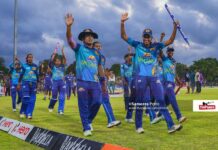The Carlton Super Sevens, a ground-breaking concept for sevens rugby in Sri Lanka and for the world, proved over the last two weeks to be a roaring success.
The tournament, was the brain-child of Parliamentarian, former national youth skipper, current Navy SC player and head of the Tharunyata Hetak youth movement, Namal Rajapakse.
The tournament organizer New Zealand born George Simpkin has shown great interest in Sri Lanka rugby for many years now, having directed the Carlton International Sevens in 2009 & 2010.
As it is in any new format the pros and cons exist and while many people attempted to focus on the negative, there were countless positives gained from this rugby extravaganza. This year Simpkin brought a spanking new look to the tournament with ten domestic teams inserted with foreign players, schools boys to the rest of the club players divided into 9 provinces and the recently liberated Jaffna. The format was worked off with franchises bidding for the players in real IPL style.
Foreign guidance-
The unprecedented infusion of the best international coaches in the world to all ten teams in the likes of Iliesa Tanivula (Fiji National Sevens coach), Willie Rickards, Paul John (World cup winning Welsh sevens Coach) and Pedro Ferdnandz (Portuguese National Coach) added immensely to Sri Lanka’s learning curve. They were able to tutor some of their skill into the players not just by lecture but in full match experiences. Appointing Sri Lanka’s top division coaches like Asanga Rodrigo, Sanath Martis, Leonard de Silva, Mothilal Jayathilake and Esala de Livera Tennakon as the assistant coaches to these maestros gave them unparalled opportunity to broaden their bases.
Many of the young stars of Sri Lanka rugby escalated their games to match up to some of these players. The local boys were tremendously lucky to have been given this opportunity to play alongside some of the best in the world. On countless occasions the foreigners were seen barking out instructions to the locals and no doubt this learning will stand Sri Lanka well.
Bigger and stronger teammates and opponents-
Another telling factor was the inclusion of foreign players. The organizers were adamant to bring down some of the best sevens players in the world and to their credit managed to do so. Some of the international players in this tournament have played twenty to thirty IRB tournaments which in the shorter version of the game is a massive number. The likes of Zar Lawrence, Ben Botica, Nalu Tuigamala, Edwin Cocker, RATU EMOSI, Eroni Ravaga and Kolani Sau added a powerful spark into the tournament.
We can hold our own-
The topic of “Is sevens the way forward for Sri Lanka rugby” is food for thought for the Sri Lankan administration. Unlike in fifteen-a-side rugby, the sevens creates opportunities for the smaller, faster, more agile players. Sri Lanka’s biggest strength is their agility and speed which on many occasions got the better of some of the big burly foreign players. Many of these players displayed that they are capable of matching up against the bigger players. Veteran Sri Lankan sevens players were also seen pushing their limits and matching one on one to the international stars. This was a rollicking sight for the Lankan public. According to Australian coach Christopher Roach “there are players in Sri Lanka who can hold their own anywhere in the world, and there are players who need a lot of development. The best way for that development is through tournaments like this”
School boy flair-
The uniqueness of this tournament was the inclusion of the high spirited school boy talent to the team rosters. Sri Lanka rugby revolves around the passion of Schools rugby, Simpkin smart to realize this added a tinge of flair and passion to the tournament by including under 21 players to the fore. Criticism was made of bringing school boys as it may lead them to serious injuries, but these school boys have been training hard for many years and at this stage are physically able to match up even to the more senior players of Sri Lanka. Rugby is a contact sport and injuries can and will happen and that’s a way of life.
In hindsight, it was clear these school boys were more than capable of matching up to the bigger foreign players. To a Sri Lankan it was exhilarating to see our young giving it their all – they were the shining light of this tournament. Some very inspiring performances from the likes of Jason Dissanayake, Shehan Pathirana, Richard Dharmapala, Randhika Alwis, Oshan Perera, Heshan Kalhara, Lavanga Perera and Mohamed Sashan proved that these boys are the driving force of Sri Lankan Rugby.
Corporate involvement-
Along with the great number of on-field positives, the Carlton sevens transported a lot of off-field encouragement into the sport. All the top corporates were represented and not just the finances but their full involvement brought- in an entire new following to the game. Firstly John Keells Holdings coming in as the platinum sponsor for the third consecutive year and Sri Lankan Airlines coming in as the official airline for the umpteenth time and Etisalat the communication sponsor yet again was very encouraging to see. Companies like Access, Ewis,Cargills, Nations Lanka ltd and LOLC made their presence felt by sponsoring the franchises. These companies having got worldwide mileage through this event will now be encouraged to come in and sponsor more rugby in the future. The SLRFU needs to capitalize on this opportunity and bring in some big sponsors for National rugby. It was a collective blue-chip effort to uplift the sport of rugby.
Players get Paid-
The biggest obstacle for Sri Lanka rugby is the inability to professionalize the game with players dedicating full time to rugby. With the inclusion of these companies, the franchise owners could afford to pay coaches and players. This could be a beacon of hope for the future of professional rugby in Sri Lanka.
World Standard Facilities for Players-
The Carlton Sevens has been renown for having some of the best facilities for the players and administration of the game. Ice baths and five-star buffets for the players were facilitated from start to finish. 24/7 medical attention for the two and half weeks of the tournament and the best hotel accommodation in Colombo and Kandy together with luxury transport was provided. Such facilities are not often seen at international seven’s tournaments. It has been said that these services are only second to those offered at the Hong Kong international sevens which was directed by George Simpkin for many years prior to coming to Sri Lanka. There aren’t too many negative points to address about the tournament as a whole, yet there are a few.
Venue-
Sri Lanka unfortunately does not have an all-equipped rugby stadium in which to host such a large scale event. Bogambara stadium, probably the best in Kandy was woefully inadequate. Royal College on the other hand was an absolutely atrocious choice and it was clear it could not handle such a large scale event. Well facilitated corporate boxes, VIP, boxes, Media boxes and a properly equipped head quarters is essential. The spectators on the far end were fenced in and had a very limited view. The only other options were CR&FC or Sugathadasa stadium. The issue with the CR is that there is very limited space for branding which not a favourite option with the corporates and Sugathadasa is too far out to pull a good crowd.
The upcoming Carlton International Stadium will definitely be a perfect venue for such a gala event and it is hoped that all required aspects have been forethought in the building process. The second leg under lights though spectacular in thought proved to be an unintelligent move as the light was barely enough to play and spectators found could not see very clearly. This also affected the Television production as the light was not enough to have a clear telecast and hampered the awards ceremony somewhat too.
Refereeing Standard-
The second leg saw 3 international referees come into the tournament which definitely helped the standards. As it has been seen all through the season, some of the decisions made by the local referees were horrific and continuously disrupted the game. On occasions the coaches were seen pacing touch lines trying to figure out the decisions made by the referee and players would look up at the referee clueless and the referee would just wave him off. The biggest difference in the standard of refereeing in Sri Lanka vs foreign, is that the international referees are constantly communicating with the players and warning them before they make a mistake. Local referees need to be trained to allow the game to flow and create a good game of rugby.
Media Coverage-
Although it was such a massive event, the media coverage seemed meager. Both in Kandy and Colombo the media was sparse and those present were severely hampered. Camera crew and photographers were restricted and the presidential security dissuades most from attending. The media box in Kandy was unclean and messy without any seats. Colombo was hardly different as the media box was scant and unable to hold a large contingent of media. Tables, chairs and power are imperative for media coverage together with names of players, schedules and scores being available at hand. The journalists were found begging around for information.
Player attitude-
Despite the fact that some of Sri Lanka’s best played their guts out matching one for one with the foreign players, yet others seemed unwilling to put their bodies on the line or use the learning opportunity. Many faked injuries and were happy to be sidelined whilst pocketing large sums and enjoying the spoils. However, the majority of the school boys played their hearts out and made Sri Lanka proud. The professionalism displayed by the foreigners was extremely commendable. It is pure proof of their supreme love for the game. Eroni Ravaga of Fiji who played for the North Western Blacks was hospitalized on Saturday but still played the following day
The Papare.com crew would like to congratulate the organizing committee on a magnificent job


















